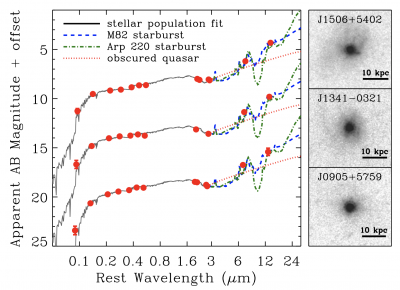Bates Galaxies Lab: Meeting Notes from September 30, 2016
Bates Galaxies Lab: Meeting Notes from September 28 and September 30
by Aleks Diamond-Stanic
Attending: Aleks Diamond-Stanic, Sophia Gottlieb, Josh Rines
Our conversation on Wednesday started with the most recent assignment, which was to look at the each of the four figures from Diamond-Stanic et al. (2012) and to capture relevant information from both a broad perspective (e.g., why is this figure important?) and a detail-oriented perspective (e.g., what does each point and each line in each panel of this figure represent?). For the broad perspective, the specific assignment was to write a single sentence (up to 50 words) to capture the main ideas. For the detail-oriented perspective, the assignment was to write a paragraph that described all aspects of the figure. We ended up spending most of the hour on Wednesday focusing on Figure 1 from that paper, which is reproduced below.

Our “mental chunk” building included discussions about the definitions of quasars and active galactic nuclei, the geometry of an accretion disk around a black hole, the AB magnitude system (compared to the Vega magnitude system), and flux density (energy/time/area/frequency) in cgs units. We went on to discuss what is meant by “star formation rate surface density” and how we measure the light from the most massive stars and infer how many stars have recently formed (i.e., the star-formation rate) by assuming a shape for the initial mass function. We discussed the H-R diagram, how luminosity relates to temperature and mass on the main sequence, and how we can learn useful information from color-color and color-magnitude plots. We then discussed the nature of spectral energy distributions, how light from a galaxy at ultraviolet and optical wavelengths is produced by stars, and how light at infrared wavelengths is produced by dust grains. Connecting to the red circles in the figure, we discussed the broad-band photometry for this sample in the ultraviolet from GALEX (in FUV and NUV bands), in the optical from SDSS (in u, g, r, i, and z bands), and in the infrared from WISE (in the W1, W2, W3, and W4 bands). We talked about how ground-based imaging for this is not sufficient to resolve these galaxies and how imaging from the Hubble Space Telescope is required. For more background about the co-evolution of galaxies and their supermassive black holes, I suggested reading an article in Science by Tim Heckman and Guinevere Kauffmann from July 2011.
On Friday, our main focus was to have a “hack hour” to produce Python code that would read in three Hubble Space Telescope images taken in three different broad-band filters and create a visualization that showed a “postage stamp” section of each image around the galaxy of interest and also showed the distribution of background pixel values in each image, along with a Gaussian fit to that distribution. The results of that hack hour are now included into the bates_galaxies_lab repository on github as jr_image_gau.py (from Josh Rines) and sg_image_gau.py (from Sophia Gottlieb). We also discussed the different characteristics of obscured vs unobscured active galactic nuclei and the typical gas velocities for clouds in the “narrow” and “broad” line regions. We then extended this discussion to the fact that the typical velocities of gas or stars will be of order (G M / r)½ (the square root of gravitational constant times the mass enclosed with a given radius divided by that radius) and how increasing the mass or decreasing the radius will lead to a deeper potential well and larger velocities. We connected this logic to why typical gas velocities (and outflow velocities) for gas near the black are ~5,000 km/s, why typical velocities in the narrow-line region are ~500 km/s, and why typical velocities in the disk of a galaxy are ~200 km/s. Following the same logic, the compact starburst galaxies that we are studying appear to have their mass concentrated within a small radius, and we discussed how this could provide a clear explanation for why their outflow velocities are much larger than those of normal galaxies. This connects to the main goal of this particular research project, which is to measure exactly how compact the stellar mass is for these galaxies and how the outflow velocities we observe compare with (G M / r)½.